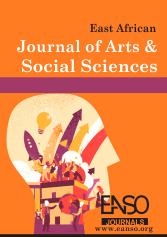Utilisation of Linguistic Landscape for Acquiring English as a Foreign Language
Abstract
This paper focuses on the role of the linguistic landscape in facilitating the acquisition of English as a Foreign Language (EFL) in Kenya’s multilingual society. It explores how different aspects of the linguistic landscape, including signs, symbols, public notices, and interactions within educational settings, support learners in engaging with and acquiring English. Linguistic Landscape Theory (LLT), which emphasises the visibility of languages in public spaces as a key factor in language learning, is employed. The paper employs a descriptive design and uses qualitative and quantitative data. The data presented is generated at three language institutes in Nairobi: the Consolata Language Centre (CLC), the Language School of Kenya (LSK), and the Kenyan Institute of Foreign Languages and Professional Studies (KIFLAPS). A purposive sampling approach was adopted to select 30 learners and 2 instructors from each institute. Data were collected through questionnaires for learners, in-depth interviews with instructors, and non-participant observation of the linguistic landscapes within the institutes. The findings reveal that the linguistic landscapes in the selected institutes were rich in visual displays, including electronic devices, printed materials, and other visual aids. These elements were strategically incorporated to support EFL acquisition by creating an engaging and visually stimulating environment. The importance of integrating real-life language usage within learning approaches and how the surrounding language environment impacts learners' language development are highlighted. It concludes that the linguistic landscape is vital in accelerating learning, enhancing information transfer, and fostering familiarity with English. It also contributes significantly to developing key language skills such as reading, speaking, and critical thinking. The paper proposes that incorporating a thoughtful linguistic landscape can create a supportive, immersive learning environment, which enhances EFL acquisition outcomes in diverse educational settings.
Downloads
References
Andriyanti, E. (2019). Linguistic landscape at Yogyakarta’s senior high schools in a multilingual context: Patterns and representation. Indonesian Journal of Applied Linguistics.
Blackwood, R. (2018). Street Signs as a Window into the Multilingual City: A Study in Belfast. International Journal of Multilingualism, 15(1), 1-18.
Choi, J., Tatar, B., & Kim, J. (2019). Bilingual Signs at an ‘English Only’ Korean University: Place-Making And ‘Global’ Space in Higher Education. International Journal of Bilingual Education and Bilingualism.
Gorter, D. (2018). Linguistic landscapes and trends in the study of schoolscapes. Linguistics and Education, 44, 80-85.
Han, Y., & Wu, X. (2020). Language policy, linguistic landscape and residents’ perception in Guangzhou, China: dissents and conflicts. Current Issues in Language Planning.
Landry, R., & Bourhis, R. Y. (1997). Linguistic landscape and ethnolinguistic vitality: An empirical study. Journal of Language and Social Psychology, 16(1), 23-49.
Lanvers, U., Hultgren, K., & Gayton, A. (2019). ‘People can be smarter with two languages’: changing Anglophone students' attitudes to language acquisition through teaching linguistics. The Language Acquisition Journal.
Muindi, D., & Gathigia, M. (2020). Multilingualism and English Language Learning in Kenya: The Role of the Linguistic Landscape. East African Language Studies, 10(1), 35-58.
Muthwii, M. (2022). Connecting Classroom Learning with Real-World Application: English Language Learning in Kenya. Global Perspectives on Education, 5(1), 60-75.
Seals, C. A. (2021). Classroom Trans-languaging Through the Linguistic Landscape. In Language Teaching in the Linguistic Landscape: Mobilizing Pedagogy in Public Space (Pp. 119-141). Cham: Springer International Publishing.
Sharma, S. (2023). English Language Teaching Methodologies: Trends, Issues, and Best Practices. Journal of International English Research Studies (JIERS), ISSN: 3048-5231, 1(2), 9-16.
Simiyu, E. E. (2019). Phonological Processes in Kipsigis Loanwords from English and Kiswahili. Doctoral dissertation, University of Nairobi, Kenya.
Spolsky, B. (2020). Linguistic Landscape: The Semiotics of Public Signage. Linguistic Landscape, 6(1), 2-15.
Wartmann, F., & Purves, R. (2018). Investigating sense of place as a cultural ecosystem service in different landscapes through the lens of language. Landscape and Urban Planning.
Copyright (c) 2025 Moses Fegher, Sheila Pamela Wandera-Simwa, PhD, Felicia Arudo Yieke, PhD

This work is licensed under a Creative Commons Attribution 4.0 International License.




























